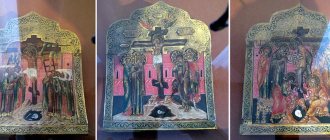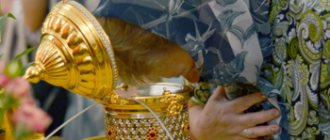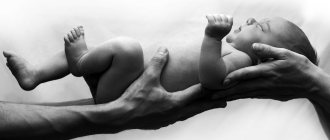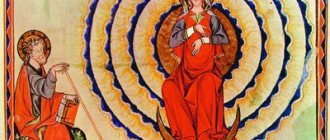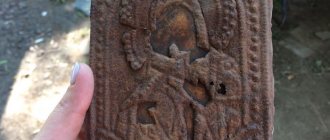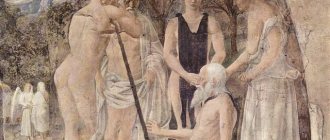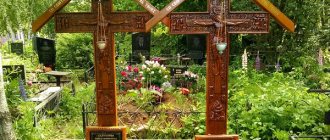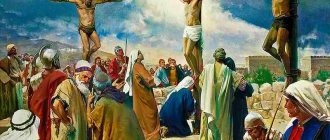General
© Onze-Lieve-Vrouwekathedraal Antwerpen (Cathedral of Our Lady of Antwerp) / www.artinflanders.be / photo: Hugo Maertens
The altar triptych “The Descent from the Cross” by Peter Paul Rubens has been in the Cathedral of Our Lady in Antwerp since its execution to this day.
The order for the triptych was signed by Rubens on September 7, 1611. The execution of the order required the artist a total of more than two and a half years of work. The central painting, depicting the scene of the Descent from the Cross, was completed and transported to the cathedral in September of the following year, 1612. The side doors, on the inside of which are depicted the scenes “The Meeting of Mary with Elizabeth” and “Bringing to the Temple”, and on the outside - “Saint Christopher”, left the artist’s workshop on February 18 and March 6, 1614, respectively. That same year, on St. Mary Magdalene's Day, July 22, the altar was solemnly consecrated. The huge painting (the dimensions of the triptych when opened are 4.2 × 6.5 meters) occupies its historical place in the cathedral on the right side of the central transept, on its eastern wall, effectively closing the perspective of the side nave.
Gospel story
The story of the removal of Jesus' body from the cross is given by all four evangelists, and each of them connects this event with the name of Joseph of Arimathea, the secret disciple of Christ. The Gospels do not describe how the removal of the body itself took place; it only tells how Pontius Pilate gave permission for this.
| Gospel | Description of the Descent from the Cross |
| From Matthew (Matt. 27:57-59) | When evening came, there came a rich man from Arimathea, named Joseph, who also studied with Jesus; He came to Pilate and asked for the body of Jesus. Then Pilate ordered the body to be given up; and Joseph took the body and wrapped it in a clean shroud... |
| From Mark (Mark 15:43-46) | ... came Joseph from Arimathea, a famous member of the council, who himself expected the Kingdom of God, dared to enter Pilate, and asked for the body of Jesus. Pilate was surprised that He had already died, and, calling the centurion, asked him how long ago He had died? And, having learned from the centurion, he gave the body to Joseph. |
| From Luke (Luke 23:50-54) | Then someone named Joseph, a member of the council, a good and truthful man, did not participate in the council and in their work; from Arimathea, the city of Judea, also expecting the Kingdom of God, came to Pilate and asked for the body of Jesus; and, taking it off, he wrapped it in a shroud and laid it in a tomb hewn [in the rock], where no one had ever been laid. |
| From John (John 19:38) | After this, Joseph of Arimathea - a disciple of Jesus, but secretly out of fear from the Jews - asked Pilate to remove the body of Jesus; and Pilate allowed it. He went and took down the body of Jesus. |
External sides of the side doors of the altar: Saint Christopher with the Child and the Hermit
© Onze-Lieve-Vrouwekathedraal Antwerpen (Cathedral of Our Lady of Antwerp) / www.artinflanders.be / photo: Hugo Maertens
On the outer sides of the side doors, which are visible when the altar is closed, a plot about St. Christopher is depicted. This saint was considered the patron saint of the guild of arquebusiers (arquebus shooters). Arquebus is a smooth-bore matchlock muzzle-loading gun.), which commissioned a triptych from Rubens; It was in honor of St. Christopher that the altar, traditionally located in this part of the cathedral, was consecrated. However, the image of Saint Christopher (and not him alone) could not become the main subject of the altar image. The fact is that starting from the second half of the 16th century, the Church strictly regulated the theme of altars in the central parts of churches: they had to depict either Christ or scenes from the New Testament. Moreover, there could not have been an image of St. Christopher on the altar, about the reliability of whose biography there were already great doubts. Despite his popularity, Saint Christopher was perceived more as a legendary figure than a real character in sacred history.
To fulfill the wishes of the customers and at the same time comply with the requirements of the Church, the artist placed the image of the patron saint of the guild on the outside of the side doors so that it was visible when the altar was closed. In addition, Rubens invented an ingenious iconographic scheme, thanks to which he was able to drag the theme of St. Christopher onto the inside of the altar, which will be discussed separately.
Today, when the famous Rubens triptych is constantly shown open, a visitor to the Antwerp Cathedral can see the composition of the altar in its closed form only in parts, looking at the reverse side of the side doors placed at a certain angle to the plane of the wall. In the 17th–18th centuries, however, the triptych was opened only on Sundays and holidays; on weekdays, parishioners saw the spectacular two-part painting “Saint Christopher and the Hermit,” the plot of which goes back to the “Golden Legend” of Jacob of Voragin, a well-known medieval collection of the lives of saints.
Left wing: Saint Christopher with the Child
© Onze-Lieve-Vrouwekathedraal Antwerpen (Cathedral of Our Lady of Antwerp) / www.artinflanders.be / photo: Hugo Maertens
Christopher, according to the description of the Golden Legend, was originally a simple-minded and uneducated man of enormous stature and exorbitant physical strength named Reprev, who decided dedicate your life to serving the most powerful king. At first he offered his services to the kings of the earth, then he tried to serve the devil, but he discovered that the devil was afraid of the cross, and turned to the holy hermit, who set him on the path of the Christian faith and advised him to help people cross the river. One night a certain baby turned to Christopher for help. When the giant carried him across the river, the burden became heavier and heavier, and the water in the river rose, and Christopher almost died, but still managed. Then the baby said to him: don’t be surprised, you carried the whole weight of the world on your shoulders, since I am the baby Christ, and immediately baptized the giant in the river, giving him the name Christopher.
Saint Christopher vs Hercules of Farnese
Top right: Hercules of Farnese. Sculpture of Glycon. IV century BC. Below: Torso of Hercules Farnese from the back. Drawing by Peter Paul Rubens from "Manuscrito de principios artísticos de Rubens (Manuscrito Bordes)". 17th century © Onze-Lieve-Vrouwekathedraal Antwerpen (Cathedral of Our Lady of Antwerp) / www.artinflanders.be / photo: Hugo Maertens;
© Museo Archeologico Nazionale di Napoli / photo: Marie-Lan Nguyen; © Museo Nacional del Prado The image of St. Christopher clearly reflects Rubens’ passion for ancient art. The gigantic figure of an athletic man is reminiscent of the famous statue of Hercules Farnese, which Rubens saw and sketched when he was in Italy. It is significant that when he appeared, the image of Christopher seemed shocking to many. The petition of representatives of the church clergy has been preserved. - readers, sextons, readers, etc.) at the temple. to the local bishop with a request to convince Rubens to drape the figure of the saint, since its nudity offends the feelings of the parishioners. The bishop, however, ignored this appeal.
Staff of Saint Christopher
© Onze-Lieve-Vrouwekathedraal Antwerpen (Cathedral of Our Lady of Antwerp) / www.artinflanders.be / photo: Hugo Maertens
In Rubens, Christopher carries a baby on his shoulders, leaning on a staff. The staff is a constant attribute of Saint Christopher, a tool of his work when crossing the river. The legend says that at the word of the baby, Christopher stuck his staff into the ground and it sprouted, turning into a fruit-bearing tree. This miracle allowed Christopher to convince many to be baptized.
Right wing: holy hermit
© Onze-Lieve-Vrouwekathedraal Antwerpen (Cathedral of Our Lady of Antwerp) / www.artinflanders.be / photo: Hugo Maertens
Rubens had to solve a difficult compositional problem. The painting with Saint Christopher should be in two parts, since it is on two interlocking panels. However, the plot with Saint Christopher is itself a one-figure story. Therefore, the artist introduces the image of the holy hermit who converted Christopher to the Christian faith, and depicts him on the second door.
Lantern in the hand of a hermit
© Onze-Lieve-Vrouwekathedraal Antwerpen (Cathedral of Our Lady of Antwerp) / www.artinflanders.be / photo: Hugo Maertens
The hermit holds a lantern with which he illuminates the path of Christopher in the night and which at the same time symbolizes the light of Christian truth shed on the giant. The fire burning in the lantern is the only source of illumination for the night scene. Visually, it unites both doors and creates a dramatic cut-off effect.
Apocryphal stories
In the apocryphal “Gospel of Peter,” written in the first half of the 2nd century, it is not reported who took the body of Jesus from the cross, but Joseph of Arimathea receives it from the Jews:
|
The apocryphal Gospel of Nicodemus (the earliest versions date back to the 4th century), written on behalf of one of the participants in the burial of Christ, adheres to the canonical account of this event:
|
Open doors of the altar triptych: three scenes
© Onze-Lieve-Vrouwekathedraal Antwerpen (Cathedral of Our Lady of Antwerp) / www.artinflanders.be / photo: Hugo Maertens
The subjects of all three scenes of the open triptych are united by the theme of carrying Christ, allegorically referring to the name Christopher, which means “carrying Christ” in Greek. . In the center of the triptych there is depicted the removal of Jesus from the cross after the crucifixion, on the left panel there is a meeting of the pregnant Virgin Mary, who is carrying the baby Jesus in her womb, with Saint Elizabeth, and on the right panel there is a scene of the bringing of the baby Christ to the temple. Thus, the theme of Christopher, so important for Rubens’ clients, is symbolically transformed in the main altar paintings.
The central part of the triptych: the descent from the cross
© Onze-Lieve-Vrouwekathedraal Antwerpen (Cathedral of Our Lady of Antwerp) / www.artinflanders.be / photo: Hugo Maertens
The central part of the triptych is the monumental “Descent from the Cross” - Rubens’ recognized masterpiece and one of his most famous painting compositions. The removal of Jesus' body from the cross for burial is mentioned in all four Gospels and is one of the most popular themes in Christian iconography. The subject was often depicted in the art of the 16th and early 17th centuries as a crowded scene with a large number of participants. Rubens brings the image closer to the foreground and limits the number of characters to eight figures (six of which are recognizable characters from Holy Scripture), forming a compact group, in the center of which is the dead body of Jesus. Christ appears before us as if in a halo of gazes turned to him and hands stretched out to him from all sides. Each character is vividly individual, each brings his own emotional note to this impressive image of universal mournful and reverent aspiration to Christ. This is how the picture visibly embodies the deep philosophical meaning of the plot from a theological point of view. “The Descent from the Cross” was understood as a symbolic expression of the sacrament of communion with the body and blood of Christ, that is, the Eucharist, the most important of the Christian sacraments.
Dead body of Christ
© Onze-Lieve-Vrouwekathedraal Antwerpen (Cathedral of Our Lady of Antwerp) / www.artinflanders.be / photo: Hugo Maertens
The pose of Christ, found by Rubens, is one of his greatest creative successes. This is a dead, severely wounded body with streaks of blood, blue hands and feet, with a head fallen on the shoulder and a dangling, awkwardly twisted arm. At the same time, this is a very beautiful plastic formula, reminiscent of high examples of ancient art. The consequences of the brutal execution and death throes are conveyed with almost frightening naturalism, but even in death, the Savior’s body, perfect in proportions and plasticity, remains beautiful. Despite all the realism of the image, the body seems weightless. The touches of the people surrounding the dead Jesus are reverent and careful, no one shows excessive physical effort. Christ seems to float in the air, solemnly and smoothly sliding down along the white veil into the arms of women waiting for him to wash and mourn. The white veil and the body of Jesus itself turn out to be the main source of light in the picture, falling on the faces and figures of the other characters. This is a reflection of the religious dogma that Christ is the light shed on humanity, vegetating in the night of sin and ignorance.
Christ vs Laocoon
Right: Laocoon and his sons. Fragment of a sculpture by Agesander of Rhodes, Polydorus and Athenodorus. 50 BC © Onze-Lieve-Vrouwekathedraal Antwerpen (Cathedral of Our Lady of Antwerp) / www.artinflanders.be / photo: Hugo Maertens;
© Museo Pro Clementino (Vatican) / photo: Jean-Pol Grandmont Almost every composition by Rubens contains hidden borrowings from the works of other artists or references to monuments of ancient art. Rubens had the rare gift of organically incorporating these quotes into his own works, masterfully using them to solve the artistic problems facing him. Thus, among several possible sources that the artist relied on when working on the image of Christ in the Antwerp painting, art historians name the famous ancient statue of Laocoon (taken in a mirror turn).
Saint John
© Onze-Lieve-Vrouwekathedraal Antwerpen (Cathedral of Our Lady of Antwerp) / www.artinflanders.be / photo: Hugo Maertens
In the foreground in the center of the composition is Christ’s beloved disciple, St. John the Evangelist. He is dressed in a wide, flowing purple robe, the rich color of which plays the role of the main colorful accent in the restrained, gloomy coloring of the picture. Placing one foot on the step of a wooden ladder, slightly leaning his whole body back, Saint John prepares to accept the body of Christ into his arms. His gaze, full of compassion, is fixed on the sorrowful face of the Mother of God.
Our Lady vs Italian samples
Bottom left: Descent from the cross. Painting by Federico Barocci. 1567–1569. Bottom right: Descent from the cross. Drawing by Peter Paul Rubens. Around 1611 © Onze-Lieve-Vrouwekathedraal Antwerpen (Cathedral of Our Lady of Antwerp) / www.artinflanders.be / photo: Hugo Maertens;
© Cattedrale di San Lorenzo, Perugia / Diomedia; © State Hermitage The Mother of God is shown standing on the opposite side of the cross, slightly in the background. She is wearing a mourning black dress and a dark blue maforium, her face stands out among everyone with its deadly pallor, her eyes full of tears are focused on her son’s face. The gesture of her hands, stretched out to the body of Jesus, expresses both an impulse to meet him, and as if a fear of touching, of finally making sure that he is dead. In solving this image, Rubens departs from the long-standing tradition of depicting the Virgin Mary in the scene of the “Descent from the Cross” as having lost her senses, drooping helplessly in the arms of her companions. This is exactly how this image is solved in the well-known paintings of the Italians Daniele da Volterra and Federico Barocci, which in many ways served as a prototype for Rubens .. The Church, however, was critical of such images, emphasizing that one should not emphasize the earthly nature of Mary and depict the Mother of God as a simple woman who lost her son, sobbing and fainting. Rubens, who in the preparatory drawing for the Antwerp altar (Hermitage, St. Petersburg) also depicted Mary sinking to the ground without strength, eventually took these requirements into account. The image he created, despite all the tragedy, is full of dignity and inner strength.
Mary Magdalene
© Onze-Lieve-Vrouwekathedraal Antwerpen (Cathedral of Our Lady of Antwerp) / www.artinflanders.be / photo: Hugo Maertens
The golden-haired, kneeling young woman in the foreground, to the left of John, is Mary Magdalene. She is dressed in an elegant open dress, leaving her shoulders and arms almost naked. This image, full of sensual charm, forms a sharp contrast to the lifeless, tormented body of Christ. With both hands, Magdalene carefully supports Jesus' leg, and his bloody foot touches her shoulder. Here we read a reference to the Gospel story about a sinner (in the Catholic tradition she is identified precisely with Mary Magdalene), who anointed Christ’s feet with precious myrrh, washed them with her tears and wiped them with her hair. Then, in response to reproaches for wasting expensive incense, Christ said: “... having poured this ointment on My body, she prepared Me for burial” Matt. 26:12.. By including this motif in the composition, Rubens thus recalls the fulfilled prophecy of Christ.
Maria Kleopova
© Onze-Lieve-Vrouwekathedraal Antwerpen (Cathedral of Our Lady of Antwerp) / www.artinflanders.be / photo: Hugo Maertens
The kneeling young woman next to Mary Magdalene is Mary of Clopas. She is mentioned in the Gospels as one of the three Marys (the so-called myrrh-bearing women) who will later come to the tomb of Christ and discover that the body has disappeared and Jesus has risen. There are discrepancies about who she is: either the sister of the Virgin Mary, or the wife or daughter of brother Joseph; there are other versions.
Mary Magdalene and Mary Kleopova
© Onze-Lieve-Vrouwekathedraal Antwerpen (Cathedral of Our Lady of Antwerp) / www.artinflanders.be / photo: Hugo Maertens
Like Mary Magdalene, Mary of Cleopas is dressed in the fashion of the 17th century (the same can be said about the characters on the side doors). The inclusion of heroes in modern dress in religious subjects was widespread in the art of the time. The subjects of Holy Scripture were not perceived as episodes from a distant era; they were thought of as timeless, repeating again and again here and now, during church services. The use of this technique enhanced the emotional impact of the image and shortened the distance between the worshipers and the characters in the gospel story.
Nicodemus
© Onze-Lieve-Vrouwekathedraal Antwerpen (Cathedral of Our Lady of Antwerp) / www.artinflanders.be / photo: Hugo Maertens
Behind the Mother of God, in a complex pose, a richly dressed bearded old man was placed on the stairs, holding the edge of the veil with one hand, and carefully supporting the forearm of Jesus with the other. This is Nicodemus, a wealthy Pharisee mentioned in the Gospel, a member of the Sanhedrin , the highest body of political and legal self-government of Judea, who believed in Christ, secretly came to him at night to talk and tried to convince him at a meeting of the Sanhedrin not to take Christ into custody. He subsequently became a Christian and was expelled from Judea; The Church canonized him as a saint. His participation in the burial of Christ is confirmed by the gospel story - it was Nicodemus who brought expensive myrrh and oil to anoint the body before burial.
Joseph of Arimathea
© Onze-Lieve-Vrouwekathedraal Antwerpen (Cathedral of Our Lady of Antwerp) / www.artinflanders.be / photo: Hugo Maertens
To the right, a bearded man in dark clothes comes down the stairs. This is Joseph of Arimathea, another wealthy and influential member of the Jewish community who believed in Christ. It was he who obtained permission from Pontius Pilate to bury the body and organized the funeral; moreover, he gave up his own tomb, prepared for future use, for Jesus.
Joseph vs youngest son of Laocoon
© Onze-Lieve-Vrouwekathedraal Antwerpen (Cathedral of Our Lady of Antwerp) / www.artinflanders.be / photo: Hugo Maertens
If the pose of Christ refers to the statue of Laocoon, then the eldest son of Laocoon from the same ancient sculptural composition, according to many researchers, is taken as the basis poses of Joseph of Arimathea.
People from above
© Onze-Lieve-Vrouwekathedraal Antwerpen (Cathedral of Our Lady of Antwerp) / www.artinflanders.be / photo: Hugo Maertens
The two people above, above the crossbar, remain anonymous. Such nameless helpers, not mentioned in the Gospels, were inevitably included by artists in the crowded scene of the descent from the cross. In Rubens's compositional plan, these two figures play an important role, closing the ring of characters surrounding Christ in the upper part of the picture. In addition, the outstretched elbow of the hand on which the gray-haired old man leans in the upper right corner of the picture sets the starting point of the main compositional axis of the picture - the dynamic diagonal along which the body of Jesus “slides” down.
Left extra vs his Italian sample
Bottom left: Wonderful catch of fish. Painting by Rafael Santi. 1515–1516. Bottom right: Descent from the cross. Painting by Daniele da Volterra. 1541 © Onze-Lieve-Vrouwekathedraal Antwerpen (Cathedral of Our Lady of Antwerp) / www.artinflanders.be / photo: Hugo Maertens;
© Victoria & Albert Museum; © Trinità dei Monti, Rome The image of a young, athletic man leaning over the crossbar and balancing on one leg on a step of the stairs is more than other elements of the painting, inspired by the art of Italy. The prototype for him was a similar character from the fresco “Descent from the Cross” in the Roman church of Santa Trinita dei Monti by Daniele da Volterra, an Italian artist of the mid-16th century, a student of Michelangelo, but he is also seen as a echo of one of the figures in the famous composition Raphael "A wonderful catch of fish."
Right extra vs his prototypes
Bottom left: Entombment. Engraving by Giovanni Batista Franco. Around 1551–1562. Bottom right: Descent from the cross. Drawing by Peter Paul Rubens. Around 1611 © Onze-Lieve-Vrouwekathedraal Antwerpen (Cathedral of Our Lady of Antwerp) / www.artinflanders.be / photo: Hugo Maertens;
© Metropolitan Museum of Art; © State Hermitage Museum The old man above on the right holds the edge of the veil in his teeth so that it does not fall. Rubens spotted this motif in one of the compositions of the 16th-century Italian engraver Giovanni Battista Franco and used it in several of his works. In the preparatory drawing kept in the Hermitage, it is played out very effectively and expressively: under the weight of the body, the veil is pulled tightly, the character barely holds it, clinging to it with his right hand and teeth. In the final version, Rubens softens the image, but retains the motif he loved. Such eloquent details, giving credibility and authenticity to the depicted scene, are often found in his works
Items in the corner
© Onze-Lieve-Vrouwekathedraal Antwerpen (Cathedral of Our Lady of Antwerp) / www.artinflanders.be / photo: Hugo Maertens
In the lower right corner of the painting, Rubens depicts a copper basin with blood flowing into it, and in it a bloody crown of thorns taken from the head of Jesus, and nails pulled out of his hands and feet. There was also a sheet of paper crushed by a stone with the inscription “Jesus Christ, King of the Jews,” which was nailed to the cross by the executioners in mockery.
Scenery
© Onze-Lieve-Vrouwekathedraal Antwerpen (Cathedral of Our Lady of Antwerp) / www.artinflanders.be / photo: Hugo Maertens
The barely outlined twilight landscape and the sky covered with dark clouds refer to the gospel story.
The soul of Christ flew away at sunset, and immediately, in the evening, his body was taken down from the cross in order to have time to bury it during the same day, before midnight, since then Saturday came, when nothing could be done. The landscape in the picture is barely visible, illuminated by the last rays of the already setting sun. The sky at the horizon is still bright, but overall there is a dominant feeling of deepening darkness, which enhances the tragic spirit of this work.
Crucifixion and death of Jesus Christ
The execution of crucifixion was the most shameful, the most painful and the most cruel. In those days, only the most notorious villains were executed with such a death: robbers, murderers, rebels and criminal slaves. The torment of a crucified man cannot be described. In addition to unbearable pain in all parts of the body and suffering, the crucified man experienced terrible thirst and mortal spiritual anguish. Death was so slow that many suffered on crosses for several days. Even the perpetrators of the execution - usually cruel people - could not look at the suffering of the crucified with composure. They prepared a drink with which they tried either to quench their unbearable thirst, or with the admixture of various substances to temporarily dull consciousness and alleviate torment. According to Jewish law, anyone hanged from a tree was considered cursed. The Jewish leaders wanted to disgrace Jesus Christ forever by condemning Him to such death.
When they brought Jesus Christ to Golgotha, the soldiers gave Him sour wine mixed with bitter substances to drink to ease his suffering. But the Lord, having tasted it, did not want to drink it. He did not want to use any remedy to relieve suffering. He took upon Himself this suffering voluntarily for the sins of people; That’s why I wanted to carry them through to the end.
When everything was prepared, the soldiers crucified Jesus Christ. It was around noon, in Hebrew at 6 o'clock in the afternoon. When they crucified Him, He prayed for His tormentors, saying: “Father! forgive them because they don’t know what they are doing.”
Next to Jesus Christ, two villains (thieves) were crucified, one on His right and the other on His left. This is how the prediction of the prophet Isaiah was fulfilled, who said: “and he was numbered with the evildoers” (Is. 53:12).
By order of Pilate, an inscription was nailed to the cross above the head of Jesus Christ, signifying His guilt. On it was written in Hebrew, Greek and Roman: “Jesus of Nazareth, King of the Jews.”
, and many people read it. The enemies of Christ did not like such an inscription. Therefore, the high priests came to Pilate and said: “Do not write: King of the Jews, but write what He said: I am the King of the Jews.”
But Pilate replied: “What I wrote, I wrote.”
Meanwhile, the soldiers who crucified Jesus Christ took His clothes and began to divide them among themselves. They tore the outer clothing into four pieces, one piece for each warrior. The chiton (underwear) was not sewn, but entirely woven from top to bottom. Then they said to each other: “We will not tear it apart, but we will cast lots for it, who will get it.” And having cast lots, the soldiers sat and guarded the place of execution. So, here too the ancient prophecy of King David came true: “They divided My garments among themselves, and cast lots for My clothing” (Ps. 21:19).
The enemies did not stop insulting Jesus Christ on the cross. As they passed, they cursed and, nodding their heads, said: “Eh! Destroying the temple and creating in three days! Save Yourself. If you are the Son of God, come down from the cross."
Also, the high priests, scribes, elders and Pharisees mocked and said: “He saved others, but he cannot save himself. If He is the Christ, the King of Israel, let him now come down from the cross so that we can see, and then we will believe in Him. Trusted in God; let God deliver Him now, if He pleases Him; for He said: I am the Son of God.”
Following their example, the pagan warriors who sat at the crosses and guarded the crucified, mockingly said: “If You are the King of the Jews, save Yourself.”
Even one of the crucified thieves, who was to the left of the Savior, slandered Him and said: “If You are the Christ, save Yourself and us.”
The other robber, on the contrary, calmed him down and said: “Or are you not afraid of God, when you yourself are condemned to the same thing (i.e., to the same torment and death)? But we were condemned justly, because we accepted what was worthy of our deeds, and He did nothing bad.” Having said this, he turned to Jesus Christ with the prayer: “Remember me
(remember me),
Lord, when You come in Your Kingdom
!
The merciful Savior accepted the heartfelt repentance of this sinner, who showed such marvelous faith in Him, and answered the prudent thief: “Truly I tell you, today you will be with Me in Paradise.”
.
At the cross of the Savior stood His Mother, the Apostle John, Mary Magdalene and several other women who revered Him. It is impossible to describe the sorrow of the Mother of God, who saw the unbearable torment of Her Son!
Jesus Christ, seeing His Mother and John standing here, whom he especially loved, says to His Mother: “Woman! Behold, Your son"
.
Then he says to John: “Behold, your Mother
. From that time on, John took the Mother of God into his home and cared for Her until the end of Her life.
Meanwhile, during the suffering of the Savior on Calvary, a great sign occurred. From the hour the Savior was crucified, that is, from the sixth hour (and according to our account, from the twelfth hour of the day), the sun darkened and darkness fell throughout the entire earth, and lasted until the ninth hour (according to our account, until the third hour of the day) , i.e. until the death of the Savior.
This extraordinary, worldwide darkness was noted by pagan historical writers: the Roman astronomer Phlegon, Phallus and Junius Africanus. The famous philosopher from Athens, Dionysius the Areopagite, was at that time in Egypt, in the city of Heliopolis; observing the sudden darkness, he said: “either the Creator suffers, or the world is destroyed.” Subsequently, Dionysius the Areopagite converted to Christianity and was the first bishop of Athens.
Around the ninth hour, Jesus Christ loudly exclaimed: “Either, Or! Lima Savahfani
! that is, “My God, My God! Why have you forsaken me? These were the opening words from the 21st Psalm of King David, in which David clearly predicted the suffering of the Savior on the cross. With these words, the Lord reminded people for the last time that He is the true Christ, the Savior of the world.
Some of those standing on Calvary, hearing these words spoken by the Lord, said: “Behold, He is calling Elijah.” And others said, “Let us see if Elijah will come to save Him.”
The Lord Jesus Christ, knowing that everything had already been accomplished, said: “I thirst.”
Then one of the soldiers ran, took a sponge, wet it with vinegar, put it on a cane and brought it to the Savior’s withered lips.
Having tasted the vinegar, the Savior said: “It is finished.”
, that is, the promise of God has been fulfilled, the salvation of the human race has been accomplished.
After this, He said in a loud voice: “Father! into Your hands I commit My spirit"
. And, bowing his head, he gave up his spirit, that is, he died.
And behold, the veil of the temple, which covered the holy of holies, was torn in two, from the top to the bottom, and the earth shook, and the stones were disintegrated; and the tombs were opened; and many bodies of the saints who had fallen asleep were resurrected, and coming out of the tombs after His resurrection, they entered Jerusalem and appeared to many.
The centurion (leader of the soldiers) and the soldiers with him, who were guarding the crucified Savior, seeing the earthquake and everything that happened before them, were afraid and said: “Truly this man was the Son of God.”
. And the people, who were at the crucifixion and saw everything, began to disperse in fear, striking themselves in the chest.
Friday evening arrived. This evening it was necessary to eat Easter. The Jews did not want to leave the bodies of those crucified on the crosses until Saturday, because Easter Saturday was considered a great day. Therefore, they asked Pilate for permission to break the legs of the crucified people, so that they would die sooner and they could be removed from the crosses. Pilate allowed. The soldiers came and broke the legs of the robbers. When they approached Jesus Christ, they saw that He had already died, and therefore they did not break His legs. But one of the soldiers, so that there would be no doubt about His death, pierced His ribs with a spear, and blood and water flowed from the wound.
.
NOTE: See Matthew (Matt. 27:33–56); from Mark (Mark 15:22–41); from Luke (Luke 23:33–49); from John (John 19:18–37).
The Holy Cross of Christ is the Holy Altar on which the Son of God, our Lord Jesus Christ, offered Himself as a sacrifice for the sins of the world.
Left side panel: meeting between Mary and Elizabeth
© Onze-Lieve-Vrouwekathedraal Antwerpen (Cathedral of Our Lady of Antwerp) / www.artinflanders.be / photo: Hugo Maertens
On the left side panel there is a scene of Mary’s meeting with Elizabeth, an episode described in the Gospel of Luke. The Mother of God, who had already carried Jesus in her womb, went to her relative (according to different versions, aunt or cousin) Elizabeth, who in her old age would also miraculously give birth to a child - John the Baptist. Seeing Mary and realizing that she was pregnant, Elizabeth touched her belly and made a prophecy that Mary would give birth to the Son of God and the savior of the world.
High porch with railings
© Onze-Lieve-Vrouwekathedraal Antwerpen (Cathedral of Our Lady of Antwerp) / www.artinflanders.be / photo: Hugo Maertens
Here Rubens solves a difficult problem: he had to arrange a rather crowded scene in a very inconvenient vertical narrow format and at the same time place it on the same level with the adjacent “Descent from the Cross” in order to maintain the overall compositional balance of the triptych. He finds a witty solution - the action takes place on the high porch of a rich house of classical architecture.
Arched skylight with peacock
© Onze-Lieve-Vrouwekathedraal Antwerpen (Cathedral of Our Lady of Antwerp) / www.artinflanders.be / photo: Hugo Maertens
Through the arched opening one can see a distant view of the river valley and the figure of a man (judging by the clothes, a peasant) walking down the stairs with his back to the viewer. In the foreground, under the arches of the porch, a peacock is depicted among other domestic birds. The peacock motif in old European art has multiple meanings, but in the context of this plot it symbolizes immortality.
Joseph and Zechariah
© Onze-Lieve-Vrouwekathedraal Antwerpen (Cathedral of Our Lady of Antwerp) / www.artinflanders.be / photo: Hugo Maertens
Next to the Virgin Mary, Rubens places Joseph, who is not mentioned in the evangelist’s story about Mary’s meeting with Elizabeth. In the Antwerp painting, however, he, contrary to iconographic tradition, is present and greets Elizabeth’s husband Zacharias, which gives the plot an understandable, human dimension; an atmosphere of a related visit of one married couple to another is created.
Maid and dog
© Onze-Lieve-Vrouwekathedraal Antwerpen (Cathedral of Our Lady of Antwerp) / www.artinflanders.be / photo: Hugo Maertens
The presence of a maid carrying a basket of food on her head and a dog jumping out of the door to greet guests only enhances this feeling. The picture reminds us of the human hypostasis of Christ, that he was born by an earthly woman and grew up among ordinary people. At the same time, the solemnity of the architectural frame, the monumentality of the figures raised high above the ground, the stinginess of gestures and the sublime nobility of the images make the viewer feel the full significance of what is happening. Saint Elizabeth is about to give birth to John the Baptist, the Virgin Mary has already carried Christ, and this foreshadowing of a great miracle that will happen in earthly life becomes the main content of the picture.
Descent from the Cross - Alexander Andreevich Ivanov
Description of the work.
The taking down of the Body of Jesus from the cross is an episode described by all four evangelists. As the apostles relate, on the evening of the day of the Crucifixion, since it was Friday, the Jewish authorities decided not to leave those executed hanging on the crosses until Saturday, but to speed up the execution. The guards broke the legs of two robbers, and Jesus, who had given up the ghost earlier, was pierced in the ribs by a spear of war.
Friends and secret disciples of Christ - Joseph of Arimathea and Nicodemus were members of the Sanhedrin, noble and rich people of Jerusalem, they took upon themselves the care of the burial of the Savior.
Joseph of Arimathea was not afraid to go to Pilate, the Roman prefect of Judea, and asked for the body of Jesus. Christ was buried in his tomb, which the elder carved for himself in the rock. Thanks to this courageous and selfless act, Joseph of Arimathea entered the gospel history, but nothing more is known about him.
Nicodemus was a secret disciple of Jesus. It appears three times in the Gospel of John. The first time he meets Christ at night, and Jesus reveals to him a new meaning of Scripture (John 3:2-18), the second time Nicodemus defends the young Rabbi at a meeting of the Pharisees (John 7: 50-53), and the third time he participates at the burial of Jesus (John 19:39).
The plot of the burial can be called programmatic in the cycle of “The Passion of the Lord.” Biblical sketches on the theme of the Passion, starting with the illustration of the Last Supper, are among the most successful sketches of Alexander Ivanov. The artist tries to express the tragic line of Christ’s suffering on two levels - through the emotional concentration of the heroes and, above all, Jesus himself, and at the same time through the slow rhythm of everything that surrounds the Savior.
“The Burial of Christ” in this sense is a sketch that continues the previous one - “Those who knew Jesus look at the Crucifixion from afar”, like a new link in the chain of the ancient frieze. The composition is built on the principle of the golden ratio. The body of the dead Jesus rests in the arms of Nicodemus and Joseph. Their symmetrical figures are consonant with the parallel of cypress trees stretching into the distance. The two secret disciples are like two supports through which the body of the Teacher taken from the cross is stretched. Joseph and Nicodemus carefully and carefully transfer Jesus onto the shroud. His mother, Mary, holds Christ’s lifeless hand. Her movement, profile, and fallen hair repeat the image of Mary from the sketch of the Crucifixion. It is, undoubtedly, She, the closest and dearest, seeing off her only Son. Behind Mary are three women, two of them opening a vessel of oil to prepare the cloth brought by the third. On the left side of the sketch, behind Joseph and Nicodemus, wars carry away the bodies of two robbers. There are crosses on the ground. The execution took place, the main one was killed, and now it’s time for peace.
All the heroes, except Joseph, Nicodemus and Jesus, are devoid of color; the artist gave them only a general outline. This decision narrows the entire surrounding, vain world of illustration to one point - the body of a dead God, hanging weightlessly in the hands of people between heaven and earth.
Watercolor by Alexander Ivanov “The Burial of Christ” is an allusion to the shroud carried out on Good Friday. Alexander Ivanov, of course, was familiar with the famous hymns of Good Friday from childhood, their measured and smooth ri and “Beautiful Joseph took down your pure body from the tree, wrapped it in a clean shroud and laid it in a new tomb with fragrant fragrances.” The artist, willingly or unwillingly, follows the words of the stichera and troparion, casting a ray of light on the body of Christ, removing unnecessary vanity and lamentations of the wives beyond the invisible boundaries of the sketch, leaving only this moment important.
In addition to the native Orthodox tradition in which Alexander Ivanov was brought up, the artist absorbed ancient culture into his flesh and blood, which allowed him to illustrate the saddest pages of the New Testament, like an ancient drama, solemnly and evenly.
History of creation.
In the last decade of his life, in 1849–1858, Alexander Ivanov worked on a large series of drawings and watercolors, called “Biblical Sketches.”
The artist dreamed of participating in the paintings of the Cathedral of Christ the Savior, but the order was given to K. Bryullov, which prompted Alexander Ivanov to come up with his own project dedicated to religious subjects of the Old and New Testaments.
He wanted to paint a certain building with frescoes, which was supposed to be something between a “temple of art” - the prototype of a museum, and a “temple of philosophy”. Several hundred watercolors became sketches for these unpainted frescoes. A project like this “Temple of Humanity” was a utopia. The planned cycle was intended to “crown all the efforts of scientists and antiquaries” by presenting the biblical world in the interpretation offered by the latest literary scholarship. For Alexander Ivanov, the book “The Life of Jesus” by D. Strauss was a revelation. The artist became interested in biblical archeology and source studies, sketching Christian monuments in Italy.
Ivanov is looking for a form of reproducing biblical reality through his sketches. The subject of close study for him is Eastern art, in which he sees the foundation of the emergence of Christianity. According to the subtle remark of one of the researchers, which M.V. Alpatov cites in his work, without naming authorship, “Ancient Eastern elements were introduced organically into the style of sketches, influencing it in the same way as they influenced Hellenism in their time during the formation of Byzantine art.” .
The biblical sketches of Alexander Ivanov, the fruit of his many years of reflection on the Old Testament and the Gospel, were recognized by such critics as A. I. Benois and V. V. Stasov, the pinnacle of his creativity, exceeding in skill the painting “The Appearance of Christ to the People.”
Sergei Ivanov, the artist’s brother, wrote: “These compositions were made by my brother over a period of 8 years, that is, from 1849 to the beginning of 1858, the time of my brother’s trip to St. Petersburg and his death. That this is so is enough evidence: the first and main thing, of course, is the drawing itself, freed from all mannerisms and becoming an easy and submissive expression of thought.” By mannerism, Sergei understood a departure from imitation of Italian masters, on which Russian academicism insisted. Now Alexander Ivanov had his own style. He gained freedom from the academic routine, which was reflected in the simplest, unconstrained turns and positions of the heroes. The landscape ceased to be a copy of Italian locales - Roman, Tuscan, but became closer to the European landscape, which the master studied from photographs of foreign travelers, most often the British. All biblical images bear the imprint of not only the East in general, but also Palestine in particular, and are vividly transported to an area truly characteristic of the Old Testament and the Gospel.
Alexander Ivanov literally lived by biblical drawings, so every single meaning that led him to achieve his life goal was immensely important, dear and interesting to him.
Ivanov’s sketches reproduce the very readiness of the ancient world for unexpected metamorphoses and the predisposition of people living in this world to experience a miracle.
The author's attitude towards faith.
Most of Alexander Ivanov's works are written on biblical subjects. In addition to full-scale paintings, such as “The Appearance of Christ to Mary Magdalene after the Resurrection” or “The Appearance of Christ to the People,” the artist worked on a large series of drawings and watercolors, called “Biblical Sketches.” Religious and historical themes are the main ones in the work of Alexander Ivanov. The writer and friend of the artist N.V. Gogol in the book “Selected Passages from Correspondence with Friends” very accurately described Alexander Ivanov during the period of his work on the canvas “The Appearance of Christ to the People”: “he died for everything in the world” and “leads a truly monastic life, working day and night on my work and praying every minute.” According to I. S. Turgenev, the artist “prays every minute” and “knows the Bible from word to word.” Nevertheless, Alexander Ivanov’s connections with A. I. Herzen and N. G. Chernyshevsky gave rise to rumors about the artist’s religious disappointment towards the end of his life. Here we should pay attention to the historical realities of the 1850s. Religious free-thinking was not welcomed; state censorship was both secular and ecclesiastical in nature. The “weakening of faith,” which the artist complained about, did not prevent him from creating a large series of biblical sketches. Such a paradox in the artist’s biography rather testifies to the complexity and versatility of his religious feelings, and to his unflagging interest in the figure of Christ throughout his life.
Ivanov’s entire life was filled and driven by the idea of depicting Christ, His life and teaching, influence on the people and dissemination of the sermon. The artist accomplished much of what he planned. In “Sketches” Ivanov drew with great talent and perfection many scenes from the life of Christ and the disciples, but everything that is significant and great here touched only on the historical and everyday side of events, while the characters themselves were executed smoothly, calmly, without bursts of expression and feeling . What a contrast to this are Ivanov’s illustrations to the Old Testament, lively, emotional, with historical realities inspired by a careful study of biblical archaeology.
Biography.
Alexander Ivanov (1806–1858) was born into the family of the artist, professor of painting at the Imperial Academy of Arts Andrei Ivanovich Ivanov. Raised from childhood in an atmosphere of creative exploration and dialogue, at the age of eleven the boy entered the Imperial Academy of Arts as an “outsider” student. He studied there with the support of the Society for the Encouragement of Artists and under the guidance of his father.
For his success in drawing, Alexander received two silver medals and was awarded a small gold medal for the painting “Priam Asks Achilles for Hector’s Body.” In 1827, he received a large gold medal and the title of artist of the XIV class for the painting “Joseph interpreting the dreams of the butler and baker imprisoned with him.”
The Society for the Encouragement of Artists decided to send Alexander Ivanov at his own expense abroad to further improve his skills, with the requirement that he paint another painting on the theme “Bellerophon goes on a campaign against the Chimera.” Having fulfilled this requirement, Ivanov went to Europe in 1830, and through Germany, with a stop for some time in Dresden, arrived in Rome. At this time, Rome was the center of the Russian intelligentsia.
In Italy, Ivanov’s first works consisted of copying Michelangelo’s “Creation of Man” in the Sistine Chapel and writing sketches for various biblical subjects. Diligently studying the Holy Scriptures, especially the New Testament, Ivanov became increasingly captivated by the idea of depicting the first appearance of the Messiah to the people on a large canvas, but before embarking on this difficult task, he wanted to try his hand at painting a smaller-scale work. So in 1834-1835 the painting “The Appearance of the Risen Christ to Mary Magdalene” appeared.
This work was a great success both in Rome and in St. Petersburg, where in 1836 the artist was awarded the title of academician for it.
Encouraged by success, Ivanov set about “The Appearance of Christ to the People.” The work dragged on for twenty years (1836–1857), and only in 1858 the artist decided to present the canvas in St. Petersburg. An exhibition of the painting itself and all the sketches and sketches related to it was organized in one of the halls of the Academy of Arts and made a strong impression on the public.
In worrying about the further fate of his painting, Ivanov, who was not always in good health, completely exhausted his body, so the slightest choleric seizures combined with a mild cold were enough to bring him to the grave. He died after a short illness on July 3, 1858 and, with a large crowd of people, was buried in the cemetery of the Resurrection Novodevichy Convent. Subsequently, the artist’s remains were reburied, and now his grave is located in the Tikhvin cemetery of the Alexander Nevsky Lavra.
Author of the text: Nadezhda Anatolyevna Zavalnaya.
Right side door: bringing to the temple
© Onze-Lieve-Vrouwekathedraal Antwerpen (Cathedral of Our Lady of Antwerp) / www.artinflanders.be / photo: Hugo Maertens
The right side door depicts the scene of the “Bringing into the Temple”, or “Candlemas”. According to the Gospel of Luke, on the fortieth day of Jesus' life, the Mother of God and Joseph, according to custom, brought him to the Temple of Jerusalem, since the law required that every first-born male child be dedicated to God. In the temple they were met by the righteous Simeon the God-Receiver, who was predicted that he would not die until he saw with his own eyes the fulfillment of the prophecy about the birth of the Messiah. Taking the baby Christ in his arms, Simeon immediately recognized him as the Savior. This plot is perhaps best known to the modern Russian reader from Joseph Brodsky’s poem “The Meeting,” where it is stated very precisely:
When she first brought the child into the church, Saint Simeon and the prophetess Anna were inside from among the people who were constantly there.
Simeon, Anna and Maria with baby
© Onze-Lieve-Vrouwekathedraal Antwerpen (Cathedral of Our Lady of Antwerp) / www.artinflanders.be / photo: Hugo Maertens
Rubens depicts the moment when Mary has already handed the baby into the hands of Simeon, who offers a prayer of thanks to God. The elderly woman in the background is the prophetess Anna, who also immediately recognized Jesus as the Son of God and spread the news about him throughout Jerusalem.
Joseph with doves
© Onze-Lieve-Vrouwekathedraal Antwerpen (Cathedral of Our Lady of Antwerp) / www.artinflanders.be / photo: Hugo Maertens
In the foreground is Joseph accompanying Mary, who knelt before the priest. In his hands he holds two chicks of a dove - a sacrificial offering to the temple, which, according to the law of Moses, was supposed to be done to cleanse the mother after childbirth.
Man on the left: Nicholas Rockox
Right: Portrait of Nicholas Rockox. Painting by Anthony Van Dyck. 1621 © Onze-Lieve-Vrouwekathedraal Antwerpen (Cathedral of Our Lady of Antwerp) / www.artinflanders.be / photo: Hugo Maertens;
© State Hermitage Museum Among the people filling the space of the temple, the man behind Simeon, whose facial features are clearly portrait-like in nature, attracts attention. This is Nicholas Rocox, a famous Antwerp philanthropist and public figure, a close friend and patron of Rubens. Coming from a wealthy merchant family, who received an excellent education at the universities of Paris and Leuven, Rocox was 17 years older than Rubens and by the time the young artist returned from Italy he was already one of the most influential people in Antwerp. He was elected mayor of the city several times, and also served as president of the guild of arquebusiers at the very moment when Rubens received an order for an altar triptych for Antwerp Cathedral. There is no doubt that Rokoks, who highly valued Rubens’ art (he had several works by the artist in his personal collection), played a key role in the fact that he received this honorable and profitable order. The appearance of Rokoks's portrait on the side flap of the triptych should probably be regarded as a gesture of gratitude on the part of the artist. A magnificent portrait of Nicholas Rococks by Van Dyck is kept today in the Hermitage, and his preserved house is one of the most popular museums in Antwerp (which is dedicated not only to Rococks, but also to his contemporary with Rubens, the painter Frans Snyders).
Church interior; Column
© Onze-Lieve-Vrouwekathedraal Antwerpen (Cathedral of Our Lady of Antwerp) / www.artinflanders.be / photo: Hugo Maertens
The marble column of the Corinthian order in the interior of the temple, which occupies a central place in the composition, can be read as an image of the pillar of faith, an allegorical allusion to the fact that that the truth brought into the world by Christ is the indestructible support of the universe.
Joseph's heel
Bottom: Madonna with rosary. Painting by Caravaggio. Around 1607 © Onze-Lieve-Vrouwekathedraal Antwerpen (Cathedral of Our Lady of Antwerp) / www.artinflanders.be / photo: Hugo Maertens;
© Kunsthistorisches Museum, Wien In the foreground, right next to the frame of the picture, Rubens shows the bare sole of Joseph’s foot.
This motif brings to mind the art of Caravaggio, with whose works Rubens was well acquainted during his time in Italy. In the famous “Madonna of the Rosary” by Caravaggio (Vienna, Kunsthistorisches Museum), the bare feet of kneeling shepherds in the foreground, painted with shocking realism, seem to almost protrude beyond the edge of the picture. Rubens highly valued this painting and a few years later managed to organize a fundraiser to purchase the Madonna of the Rosary for one of the Antwerp churches. The indicated detail in “Bringing to the Temple” is undoubtedly a deliberate Caravaggist quotation. Tour of the Rubens House Museum in Antwerp We walk through the Italian courtyard, gallery and studio of the artist together with the curator and director of the museum Ben van Beneden.
